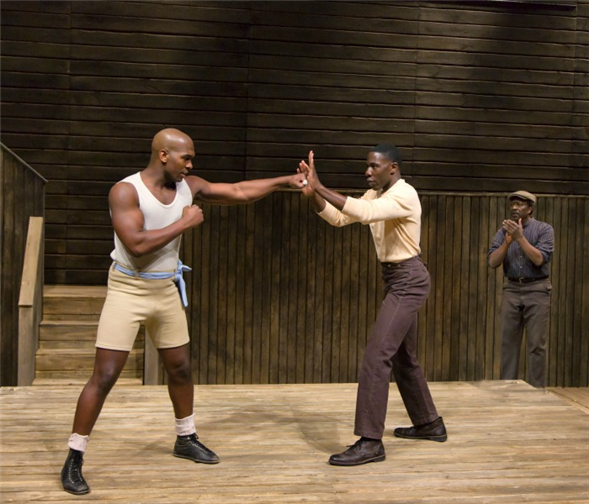Translate Page

Director Rachel Chavkin finds an innovative way to bring the excitement of boxing to the stage
---
In boxing, timing and stamina are indispensable. The same attributes have been invaluable for Rachel Chavkin's knockout of a career. During the past few years, the much-sought-after theatre director has been brutally busy, somehow finding a way to balance her duties as the artistic director of the Brooklyn-based company The TEAM with helming multiple iterations of the immersive musical Natasha, Pierre & the Great Comet of 1812 (which will mark her Broadway debut this fall) as well as a slew of Off-Broadway projects like Small Mouth Sounds and Preludes. So it seems fitting that she's currently represented on the NYC boards by The Royale, Marco Ramirez's powerful pugilist play set in the early 20th century and inspired by the real-life experiences of Jack Johnson, the first African-American heavyweight world champion.
Chavkin previously directed the show in 2014 at San Diego's Old Globe Theatre at the invitation of its artistic director, Barry Edelstein, who sent her the script. "I don't think I moved while I was reading it," she remembers. "I immediately wrote back and said, 'Yeah, I definitely want to find time to do this.'" For that production, she developed an innovative way to stage the boxing matches, which also serve as a metaphor for the racism and inner demons Johnson (rechristened Jay Jackson here) must battle. The actors don't touch each other -- they rarely come within fist's reach. Instead, when blows connect, they're communicated by the performers jumping up and landing with a thunderous thud, or lifting a movable railing high into the air and bringing it down in a loud crash. These inventive tricks invest the bouts with an exciting, heart-pumping energy that's often lacking in traditionally choreographed (but obviously faked) stage fights.
Since Chavkin specializes in new works, her process is always heavy on playwright collaboration. So from the outset, she asked Ramirez about his vision for The Royale. "It's my happiest work with writers if they give an incredibly vivid core initial image," Chavkin explains. "Marco told me, 'You know, I wrote this play for a black box and chalk,' as in the stuff you might rub on your hands, or the inspiration for the powder on the punching bag. So that kind of really, really strict simplicity stuck with me. It was such a powerful core image in the way that Dave [Malloy]'s initial image of Natasha was this night he spent at Café Margarita in Moscow, a Russian club he had stumbled into with no sign on the door and with this string trio spread throughout the space. I took that and made a whole production concept out of it."
{Image1}
For her second go-round with The Royale, now at Lincoln Center's semicircular Mitzi Newhouse Theater, Chavkin retained much of what she did in California, with one notable addition: the casting of an ominous, larger-than-life shadow on the back wall at a few pivotal moments in the taut, 90-minute show. "The Old Globe was totally in the round, which really lent its feel to the boxing and the energy," she says. "But at the same time, it's very challenging to make a composition in the round because something that looks really great from one angle may not from another. So the thing that we kept from the Old Globe was that feeling of constantly moving. Yet at Lincoln Center, the thing we get to do which we didn't at the Old Globe is cast that shadow. It was an idea we had discussed, trying to build a screen in the middle and have shadow play beyond it. But it felt too complicated so we killed it. But we brought it back in New York."
Without giving too much away, that shadow -- besides being a seriously awesome visual -- works as a potent symbol. Jay is a champion, yet he's been forced to fight out of the spotlight because of Jim Crow. That shadow hangs over everything he does. Even when he manages to entice the white titleholder to come out of retirement to face him, it's not at all on Jay's terms. Win or lose, Jay knows there's a great price to be paid.
That effect -- along with moments of direct audience address and vintage-style boxing posters bleeding over into the house -- give the show an immersive feel. And that's exactly what Chavkin was going for. "It's lovely that you use the word immersive for The Royale because of course it's not really," she says. "But it speaks to what I care most about in theatre, which is that the audience feels the feelings of the play as much as possible -- whatever they may be."
---
Follow Raven Snook at @RavenSnook. Follow TDF at @TDFNYC.
Photos by T. Charles Erickson. Top image: Khris Davis, McKinley Belcher III and Clarke Peters in The Royale.
TDF MEMBERS: Browse our discounted tickets to theatre, dance, and concerts.